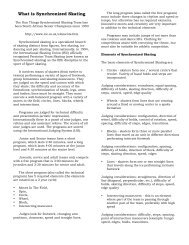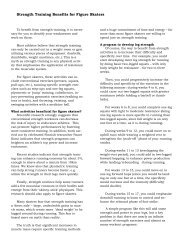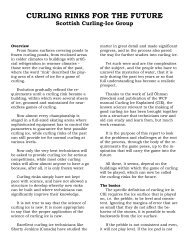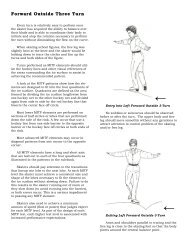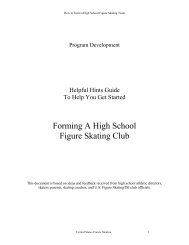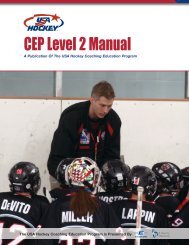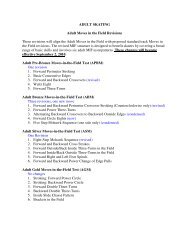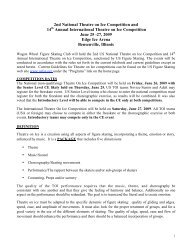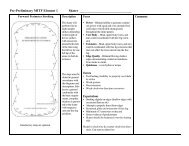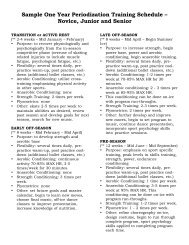CEP Level 3 Manual - Rushmore Hockey Association
CEP Level 3 Manual - Rushmore Hockey Association
CEP Level 3 Manual - Rushmore Hockey Association
Create successful ePaper yourself
Turn your PDF publications into a flip-book with our unique Google optimized e-Paper software.
T A B L E O F C O N T E N T SBreakout Zone1. Center stays between the circle, close to thetop of the circle2. Always angle toward side boards whenreceiving passNeutral Zone1. Move up ice in the middle zone, betweenthe seamsAttack Zone1. Playmaker - usually passes to a wing2. Without Puck• Trail the puck carrier at top of circle(or skate hard to front of net)3. With Puck, Over Blue Line• Stop in middle, just before top ofcircle, and pass to wing or shootWING – OFFENSIVE RESPONSIBILITIESBreakout Zone1. Strong-side Wing• Position yourself against the boardsat the hash marks to receive abreakout pass2. Weak-side Wing• Move to top of face-off circle whenpuck goes to the other side• Move out of zone along seamNeutral Zone1. Both wings should stay in outside lanesAttack Zone1. Puck Carrier• Quickly penetrate zone on top ofcircle• Options: go to net and shoot; passback to trailer (center); pass to weaksidewing in front2. Weak-Side Wing• Stay wide when coming into zone• Skate into face-off dot and angle tonet174 | USA <strong>Hockey</strong> Coaching Education Program <strong>Level</strong> 3 <strong>Manual</strong>Chapter 15Team PlayINTRODUCTIONOBJECTIVES• Describe skills needed for successful team play in hockey• Outline the sequence to be used in introducing team play• Present some of the unique formations that are effective in youth hockeyMany good books on hockey have beenpublished recently, and nearly all have excellentsuggestions for team offense and defense. Coacheswith teams of experienced players who are strong inthe fundamentals of hockey should benefit fromreviewing one or more of these publications.This chapter is devoted to some relatively basicoffensive patterns and defensive assignments thatmay be used by teams at all levels. First, a fewintroductory comments.Beginning hockey players soon figure outthat offensive means getting in scoring position andscoring goals. Defense means stopping the offenseand recovering the puck. This simple assessment issufficient to permit the game to be played. A coachhas the opportunity, however, to explain whycertain things will happen on the ice and then toteach the players to create situations rather thanjust letting them happen.The first question a coach must resolve is,“When are we on offense?” The offense-or-defensequestion centers on control of the puck. Team puckcontrol falls into three categories.1. We have it – we are on offense2. They have it – we are on defense3. Nobody has it (loose puck). This is thecondition that the game is all about. If wewin the race to the loose puck, we go onoffense. If not, we are on defense. Animportant principle of play, therefore, is towin most of the races to the puck (the teamwhich wins the races for loose pucks usuallywins the game).From an offensive or defensive standpoint, youshould teach your players that when we are onoffense we control the puck; at all other times, weare on defense. This will put your team into adefensive pattern when you go after loose pucks.The object of team offense is to control the pucklong enough and well enough to get a good shot ongoal. Here are some simple offensive patterns forthe three zones.POSITION OFFENSEWhen left alone, most young hockey players willfall into the “swarm” system or (non-system) ofoffense and defense. In this “system” everybodygoes where the puck is. If you can get your playersOffensive Team Tactics | 175



